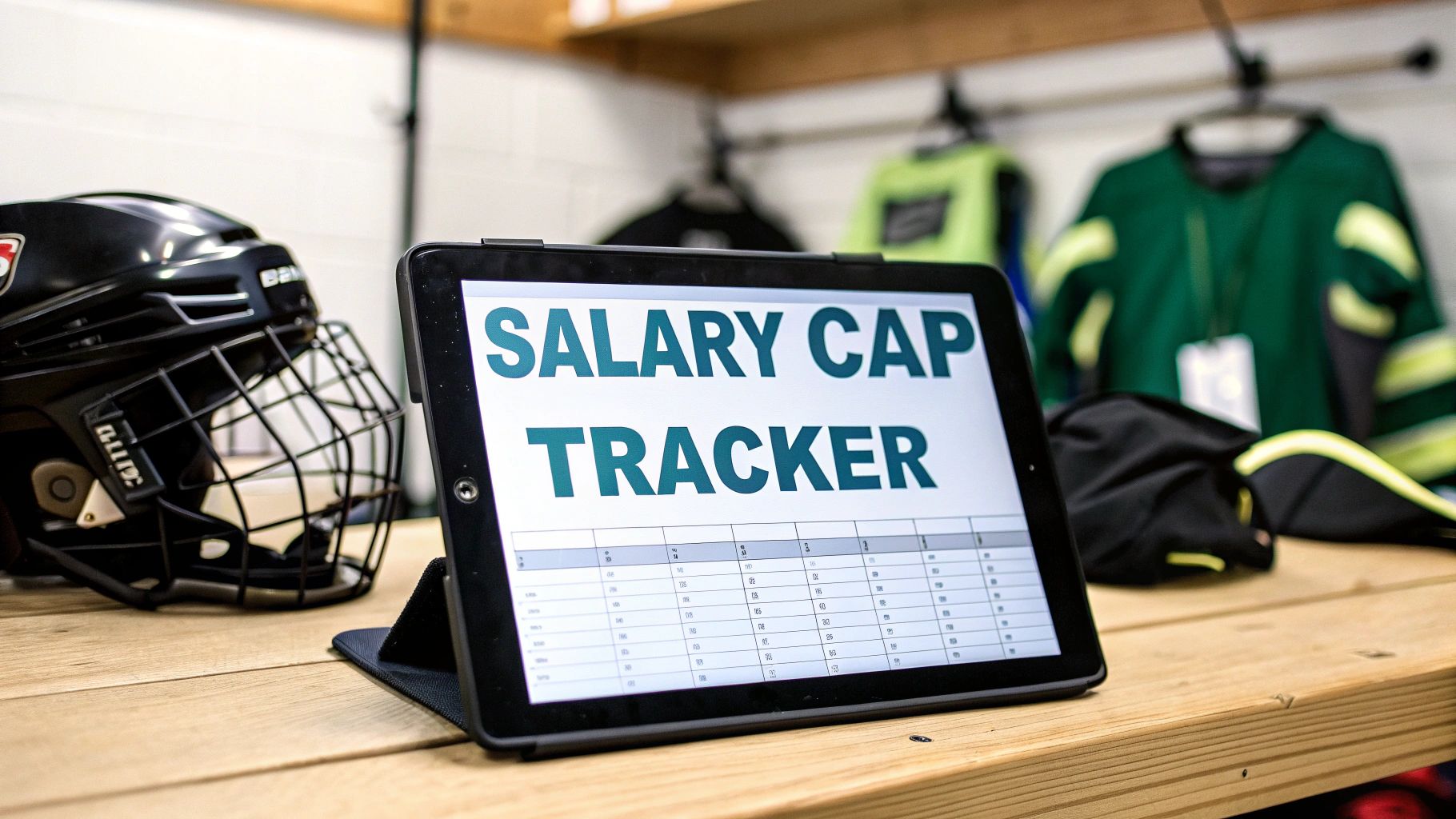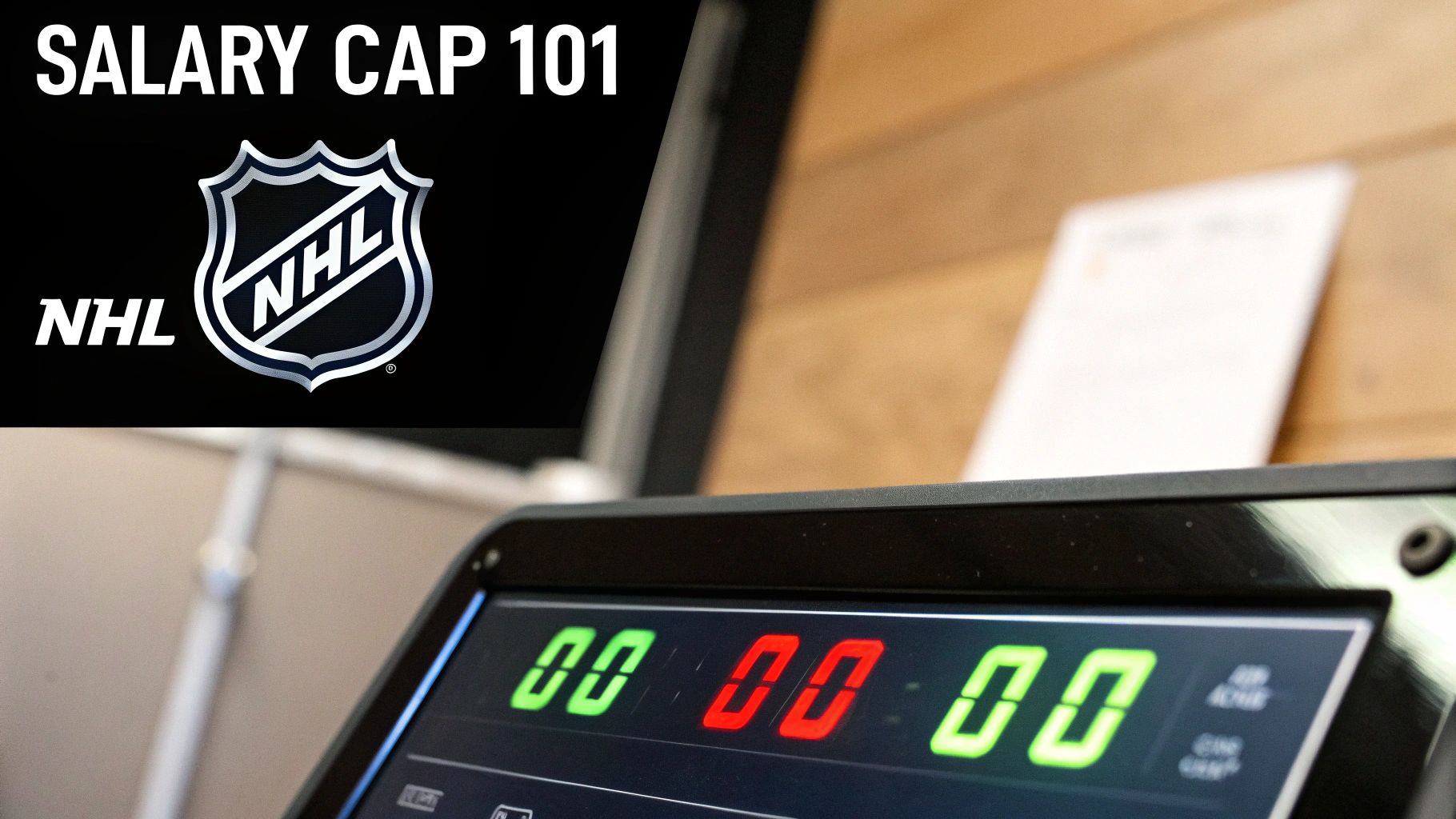Your Guide to an NHL Salary Cap Tracker

At its core, an NHL salary cap tracker is an online dashboard that shows you exactly how every team is spending its money. It’s the ultimate tool for seeing which teams are flush with cash and which are pressed right up against the league's hard budget limit.
These trackers give you a real-time look at a team's financial health, detailing every player contract, potential bonus, and future commitment.
Understanding the NHL Salary Cap

Before you can really get the most out of a tracker, you have to understand the salary cap itself. It’s the single most important concept in modern NHL team building.
Think of it as a strict annual budget for player salaries. Every single contract is an expense that has to fit under this ceiling, which helps create a more level playing field between big-market powerhouses and smaller franchises.
This structure is what turns every roster move into a complex chess match. A salary cap tracker simply visualizes that budget, letting you see exactly how a general manager (GM) is playing the game.
The Ceiling and the Floor
The salary cap system has two main parts that dictate spending for all 32 teams. These are the absolute boundaries a team has to stay within all season long.
- Cap Ceiling: This is the absolute maximum a team can spend on player salaries in one season. You can't go over it. Period. This forces GMs to get creative with contracts, trades, and roster construction.
- Cap Floor: This is the mandatory minimum a team must spend. It’s there to stop teams from just icing a cheap, non-competitive roster to save a buck, ensuring a baseline of talent across the league.
A team's available cash is usually called 'cap space' or 'cap room.' It's the difference between their total salaries and the cap ceiling. This number is the lifeblood of a team's flexibility to make trades or sign free agents.
A Brief History of the Cap
The modern salary cap completely changed the league's financial structure. It came into being after the 2004-05 NHL lockout and has been rising ever since, reflecting the league's growing revenues.
It was first introduced for the 2005-06 season at just $39 million per team—a number that seems tiny today. This system was crucial for creating stability, especially for Canadian teams, by preventing out-of-control spending.
Once you know the rules of the financial game, you can start to see how the best GMs bend them to their will. For a closer look at how each franchise is built, check out our detailed breakdown of all NHL teams.
How to Read an NHL Salary Cap Tracker

Cracking open an NHL salary cap tracker for the first time can feel like you’ve stumbled into the matrix. You’re hit with a wall of player names, numbers, and cryptic abbreviations. It looks complicated, but I promise it’s not.
Once you know what a few key terms mean, that confusing spreadsheet suddenly snaps into focus, giving you the complete financial picture of your favourite team. Let’s break down the most important data points you’ll find. Think of it as the legend for your team’s financial map.
The screenshot above shows a typical team page, laying out every contract and its impact. This is mission control for understanding a team’s flexibility—or lack thereof.
Decoding the Core Metrics
When you zero in on a player's contract, just a few columns tell most of the story. They don't just show what a player earns; they explain how that deal fits into the team's overall budget puzzle.
Here are the essential terms you absolutely need to know:
- Salary: This is the actual cash a player gets paid in a specific season. It often changes year-to-year, even on a long-term deal.
- Cap Hit (or AAV): This is the big one. Standing for Average Annual Value, it’s the number that actually counts against the team's salary cap each year. The AAV smooths out a player’s earnings over the life of the contract, so the team has a consistent number to work with, even if the real salary fluctuates.
- Contract Status: This tells you what happens when a player's deal is up. They'll either be an Unrestricted Free Agent (UFA), free to sign with anyone, or a Restricted Free Agent (RFA), where their current team has the right to match any offer sheet.
These three pieces of information are the fundamental building blocks for understanding any player’s impact on the roster.
Key Takeaway: The Cap Hit (AAV) is the number that truly matters for team building, not the player's yearly salary. A GM's primary job is to make all the team's cap hits fit under that league-wide ceiling.
Understanding Team-Level Finances
Beyond individual players, a good NHL salary cap tracker gives you the 10,000-foot view of the team’s entire financial situation. This is where you see the consequences of all those contracts added together.
Look for a summary section, usually right at the top of the page. It’ll have these vital stats:
- Projected Cap Space: This is the money a team has left to spend under the cap. A team with a ton of projected space can be a major player at the trade deadline or in free agency.
- Salary Retained: When a team trades a player, they can agree to keep a chunk of that player's cap hit on their own books. This "dead money" still counts against their cap but makes the player cheaper for the acquiring team.
- Buyouts: This is the cap penalty a team takes when they terminate a player's contract early. It spreads a smaller cap hit over twice the remaining length of the original deal.
These metrics reveal a team's true strategic position. A deal with retained salary, like the one still impacting the Canadiens for Carey Price, can handcuff a team’s flexibility for years. You can see just how complex those situations get in our deep dive on the Carey Price contract situation.
Once you get a handle on these concepts, you'll move from just watching the game to truly understanding the front-office chess match behind it.
Key Cap Rules Every Fan Should Know
The salary cap isn’t just one big number. It’s a living, breathing system full of weird rules that savvy general managers exploit to get an edge. Learning these little mechanisms is what turns a page of numbers on an NHL salary cap tracker into a real strategic roadmap.
Let’s untangle the three big ones you’ll see all the time: Long-Term Injured Reserve (LTIR), Performance Bonuses, and Contract Buyouts. Once you get these, you’ll have a much better feel for the financial chess match happening behind the scenes.
Navigating Long-Term Injured Reserve (LTIR)
Think of Long-Term Injured Reserve (LTIR) as a team’s emergency fund for a catastrophic injury. When a player is set to miss at least 10 games and 24 days of the season, a team can place them on LTIR to get some temporary cap relief.
This doesn't just make the player's cap hit vanish. Instead, it lets the team go over the salary cap ceiling by an amount up to that injured player's cap hit. It's a crucial bit of flexibility. Say your star goalie goes down; LTIR gives the GM the freedom to acquire a capable replacement without being totally handcuffed by the injured player’s salary.
This visual shows which teams are tight against the cap—a huge factor in how they handle injuries or swing a mid-season trade.
You can see right away that teams with almost no cap space depend heavily on tools like LTIR just to keep a competitive roster on the ice.
The Double-Edged Sword of Bonuses
Performance bonuses are extra cash paid to players for hitting specific milestones, like scoring 20 goals or playing 40 games. They’re most common for guys on entry-level deals or older veterans signing cheap one-year contracts.
But these bonuses come with a catch. If a team doesn't have enough cap space to pay them out when the season ends, the leftover amount becomes a bonus overage penalty.
This penalty gets tacked onto the team's salary cap for the next season. It’s like putting a big purchase on a credit card—you get what you want now, but the bill always comes due.
A good cap tracker will show you which teams are carrying these overages, giving you a sneak peek at which clubs are starting next season with a financial handicap already locked in.
The Lingering Pain of a Buyout
A contract buyout is the NHL’s version of a messy breakup. When a team decides a player's long-term contract just isn't worth it anymore, they can "buy it out" to terminate the deal early.
This isn't a clean break, though. The team has to pay the player a chunk of their remaining salary, and the resulting cap hit penalty is spread out over twice the remaining length of the contract. It offers a little relief now but creates "dead money" that clogs up the books for years, killing future flexibility.
Here's a quick breakdown of these common cap tricks and how they really affect a team's spending power.
Common NHL Cap Mechanisms Explained
| Mechanism | What It Does | Typical Impact on Cap Space |
|---|---|---|
| Long-Term Injured Reserve (LTIR) | Allows a team to exceed the cap ceiling to replace a seriously injured player. | Provides temporary relief, but doesn't erase the original cap hit. |
| Performance Bonus Overage | A penalty applied to next year's cap when this year's bonuses can't be paid. | Reduces future cap space, acting like a financial hangover. |
| Contract Buyout | Terminates a player's contract early at a reduced cost. | Creates a smaller, long-term "dead money" cap hit for years to come. |
Each of these tools gives a GM options, but they all come with trade-offs. LTIR is a short-term fix, bonus overages mortgage the future, and buyouts are a long, slow financial pain.
Thinking Like a GM: Cap Space as a Weapon

This is where you stop just reading an NHL salary cap tracker and start using it to think like a general manager. For the best GMs in the league, cap space isn't just a restriction holding them back; it's a powerful asset they can use offensively to build a championship contender.
Smart teams get this. They know financial flexibility is a weapon. While other franchises are desperately trying to shed salary, a team with open cap space can dictate the terms of the market. They get to pounce on opportunities that other teams are forced to create. It's the difference between reacting to the league and actively shaping it.
Becoming the Third-Party Broker
One of the most creative ways GMs weaponize their cap space is by acting as a "third-party broker" in trades. Picture this: two teams are trying to make a deal, but the acquiring team simply can't afford the player's full cap hit. This is where a team with space, like the Calgary Flames have done in the past, can jump in.
They agree to "retain" a chunk of the player's salary on their own books. In return for this service, they get a valuable asset—usually a draft pick. The team with space essentially buys a draft pick by renting out its financial flexibility.
A team can retain up to 50% of a player's salary in a trade. This trick allows cap-strapped contenders to acquire talent they otherwise couldn't afford, while the brokering team gets paid in future assets just for facilitating the deal.
This tactic doesn't cost them a single player off their roster but nets them a real, tangible gain for the future. And you can see it all laid out on a detailed salary cap tracker, right there in the "Retained Salary" section.
Exploiting Cap-Strapped Rivals
Another killer strategy is swooping in to grab top talent from teams stuck in a cap crunch. When a rival is pressed hard against the ceiling, they lose all their negotiating leverage. They have to move a contract, and every other GM in the league knows it.
Suddenly, it's a buyer's market. A team with available cash can acquire a valuable player for a fraction of what they would normally cost on the trade market. The selling team is just happy to get the salary off their books and will often take back a minimal return to make it happen.
This is how smart teams add impactful players without giving up key pieces of their own roster or high-end draft picks. For example, the Edmonton Oilers have historically needed to find cost-effective depth to support their superstars, making these kinds of value deals absolutely essential for them.
The financial landscape is always shifting, and the cap itself is a moving target. For instance, the NHL salary cap ceiling for the 2024-25 season was set at $88 million, a big jump that gives GMs more room to breathe. This kind of increase, driven by rising league revenues, directly impacts how teams plan their payrolls and pursue talent. You can dig deeper into this with these insights on superstar contracts and the rising salary cap.
Navigating the Off-Season Cap Management Chess Match
The off-season is where a general manager really earns their paycheque. This is the time when the numbers on an NHL salary cap tracker get turned into an actual on-ice roster. It's a high-stakes chess match of drafting, signing, and trading that literally sets the tone for the entire season to come.
It all kicks off with the NHL Draft, where teams gamble on the next generation of superstars. While it’s all about hope and excitement, every single pick represents a future cap commitment. An entry-level contract (ELC) for a top prospect is a bargain, but a smart GM is already thinking three years ahead, figuring out how that player's second contract will fit into the puzzle.
That kind of long-term planning is impossible without a good cap tracker to visualize it all.
The Free Agency Frenzy
Right after the draft, the real chaos begins: free agency. On July 1st, an NHL salary cap tracker becomes your best friend, showing you in real-time which teams have the financial firepower to chase the biggest names on the market.
You can instantly see who the "buyers" are—teams with millions in projected cap space—and who are just "spectators," stuck right up against the ceiling with no room to move. Every signing sends ripples across the league, and a tracker lets you follow the money.
The off-season isn't just about adding shiny new players; it's about making calculated financial moves that affect a team's competitive window for years. Every dollar spent on a free agent is a dollar that can't be used to re-sign a homegrown star down the road.
Arbitration and Tough Choices
The summer also brings the salary arbitration process for Restricted Free Agents (RFAs). This is where things can get tense. If a player and team can't agree on a new deal, a neutral third party steps in to set the salary. The outcome can completely throw a wrench in a GM's plans, creating an unexpected cap crunch.
A higher-than-expected arbitration award might force a team into a corner. Do they accept the salary and scramble to clear space somewhere else? Or do they walk away from the player entirely? This is where a GM’s careful budgeting gets put to the ultimate test.
Keeping an eye on potential arbitration cases is a great way to see which teams might be forced into making a trade. You can explore our dedicated page to keep up with all the latest NHL trades.
Common Questions About the NHL Salary Cap
Even when you get the big picture, the NHL’s financial rulebook has some sneaky details that can trip anyone up. This is where a good NHL salary cap tracker really shines, but a few questions always seem to pop up as fans start digging into their team’s situation. Let’s clear up a few of the most common ones.
Answering these will fill in the last few gaps and give you the confidence to break down roster moves like a seasoned pro.
How Is the Daily Cap Hit Calculated?
We usually talk about player salaries in terms of their annual cap hit, but the NHL actually tracks everything on a daily basis. A team’s total cap hit is calculated each day over the 186-day regular season. This is why you’ll often see a minor leaguer called up for a single game and sent right back down—it’s all about daily accounting.
A player with a $1 million cap hit doesn't actually count for the full million on day one. Their daily cap charge is their annual hit divided by the number of days in the season. This lets teams make short-term moves and bank tiny bits of cap space over time, which can become a huge weapon around the trade deadline.
What Is a 35+ Contract?
The "35-plus" contract is a specific rule meant to stop teams from using long, front-loaded contracts to get around the cap with older players. If a player signs a multi-year deal when they are 35 years old or older (as of June 30th of the year the contract begins), that contract gets hit with a major penalty.
Unlike a standard deal, the AAV of a 35+ contract counts against the cap for its entire length, even if the player retires.
Key Insight: This rule means there’s basically no cap benefit if a player on a 35+ contract hangs up their skates early. The team is stuck with that cap hit no matter what, making long-term deals for aging vets a massive risk.
This is a critical detail that any good NHL salary cap tracker will flag, showing you exactly which teams are carrying these inflexible deals.
Can a Team Trade a Player on LTIR?
Absolutely. A player on Long-Term Injured Reserve (LTIR) can be traded, and it happens more often than you’d think. It’s a common move around the trade deadline, especially when teams are trying to acquire cap space or future assets. The team that acquires the player takes on their contract and can keep them on LTIR as long as they remain injured.
For a team pressed right up against the cap, trading for an injured player's contract can be a clever way to get immediate financial breathing room. They're essentially acquiring the ability to use the LTIR relief that comes with that player's cap hit. It's one of the more advanced tricks GMs pull to maximize their spending power.
At PuckNStick, we provide the tools and data you need to become a smarter fan. From detailed player stats to comprehensive team analytics, our platform helps you see the game from a whole new angle. Explore our full suite of resources at https://www.pucknstick.com and start thinking like a GM today.
